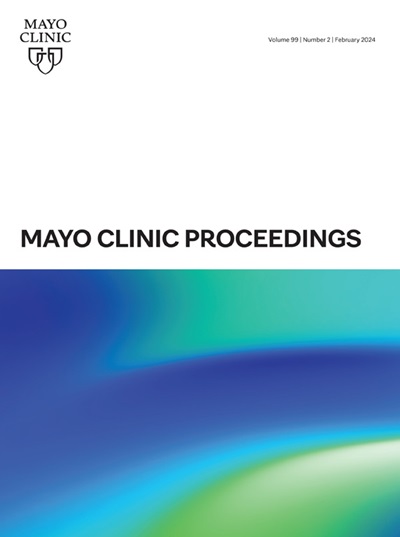加速度计衍生的“周末战士”体力活动与全因和特定原因死亡率。
IF 6.9
2区 医学
Q1 MEDICINE, GENERAL & INTERNAL
引用次数: 0
摘要
目的:探讨“周末战士”(WW)模式和一周内分布的体力活动与死亡风险的关系。参与者和方法:在这项队列研究中,2013年至2015年英国生物银行的95,468名参与者,参与者按加速度计得出的身体活动水平分组:不活动(中度至剧烈身体活动[MVPA])结果:在中位7.92年的随访期间,发生了3539例死亡。与不运动的参与者相比,经常运动的参与者的全因死亡率风险比为0.74 (95% CI, 0.68至0.82),而积极运动的WW参与者的全因死亡率风险比为0.72 (95% CI, 0.67至0.78)。在大多数特定原因的死亡中,特别是癌症、心血管疾病和呼吸系统疾病造成的死亡,也出现了类似的风险降低。这些益处在久坐13小时或更长时间的参与者中更为显著(经常运动:0.58[0.41至0.83];活跃WW: 0.70[0.55至0.88])或60分钟/天或更少的轻度体力活动(活跃规律:0.59[0.42至0.83];活性WW: 0.47[0.35 ~ 0.63])。在不同年龄组中,无论活动频率和时间如何,均观察到全因死亡风险的类似降低。结论:在一周内均匀分布并集中在1 - 2天内的体力活动与全因死亡率和大多数类别的特定原因死亡率的风险相似。本文章由计算机程序翻译,如有差异,请以英文原文为准。
Accelerometer-Derived "Weekend Warrior" Physical Activity and All-Cause and Cause-Specific Mortality
Objective
To examine the association of “weekend warrior” (WW) pattern and physical activity distributed throughout the week with mortality risk.
Participants and Methods
In this cohort study of 95,468 participants in the UK Biobank from 2013 through 2015, participants were grouped by accelerometer-derived physical activity levels: inactive (moderate to vigorous physical activity [MVPA] <150 min/wk using World Health Organization guidelines), active WW (≥150 minutes of MVPA per week and ≥50% of total MVPA over 1 to 2 days), and active regular (≥150 minutes of MVPA but not active WW). Cox regression analyzed associations of activity patterns with all-cause mortality and 10 categories of cause-specific mortality and whether the association differed by sedentary time (6, 7 to 12, or ≥13 hours) and light physical activity (60, 61 to 150, or ≥151 min/d).
Results
During the median 7.92 years of follow-up, 3539 deaths occurred. Compared with the inactive participants, the hazard ratio for all-cause mortality was 0.74 (95% CI, 0.68 to 0.82) in active regular participants and 0.72 (95% CI, 0.67 to 0.78) in active WW participants. Similar risk reductions were noted in most cause-specific deaths, especially for those from cancer, cardiovascular disease, and respiratory diseases. These benefits were more profound among participants with 13 or more hours of sedentary time (active regular: 0.58 [0.41 to 0.83]; active WW: 0.70 [0.55 to 0.88]) or 60 min/d or less of light physical activity (active regular: 0.59 [0.42 to 0.83]; active WW: 0.47 [0.35 to 0.63]). A similar reduction in all-cause mortality risk was observed across different age groups regardless of activity frequency and timing.
Conclusion
Physical activity evenly distributed throughout the week and concentrated within 1 to 2 days are both associated with similar lower risks of all-cause mortality and most categories of cause-specific mortality.
求助全文
通过发布文献求助,成功后即可免费获取论文全文。
去求助
来源期刊

Mayo Clinic proceedings
医学-医学:内科
CiteScore
16.80
自引率
1.10%
发文量
383
审稿时长
37 days
期刊介绍:
Mayo Clinic Proceedings is a premier peer-reviewed clinical journal in general medicine. Sponsored by Mayo Clinic, it is one of the most widely read and highly cited scientific publications for physicians. Since 1926, Mayo Clinic Proceedings has continuously published articles that focus on clinical medicine and support the professional and educational needs of its readers. The journal welcomes submissions from authors worldwide and includes Nobel-prize-winning research in its content. With an Impact Factor of 8.9, Mayo Clinic Proceedings is ranked #20 out of 167 journals in the Medicine, General and Internal category, placing it in the top 12% of these journals. It invites manuscripts on clinical and laboratory medicine, health care policy and economics, medical education and ethics, and related topics.
 求助内容:
求助内容: 应助结果提醒方式:
应助结果提醒方式:


